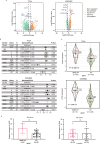Heparanase modulates the prognosis and development of BRAF V600E-mutant colorectal cancer by regulating AKT/p27Kip1/Cyclin E2 pathway
- PMID: 36130926
- PMCID: PMC9492760
- DOI: 10.1038/s41389-022-00428-0
Heparanase modulates the prognosis and development of BRAF V600E-mutant colorectal cancer by regulating AKT/p27Kip1/Cyclin E2 pathway
Abstract
BRAF V600E-mutant colorectal cancer (CRC) is a rare subtype of colorectal cancer with poor prognosis. Compelling evidence indicates that the heparanase (HPSE) gene has multiple functions in cancer, however, its role in BRAF V600E-mutant CRC remains elusive. Differentially expressed genes between BRAF V600E-mutant and wild-type patients were explored by analyzing public data from The Cancer Genome Atlas and the Gene Expression Omnibus. Clinical samples of 172 patients with BRAF V600E-mutant CRC diagnosed at Zhongshan Hospital Fudan University were collected. Overall survival was analyzed using Kaplan-Meier curves and Cox regression models. Cell models and xenografts were utilized to investigate the effect of HPSE on tumor proliferation. HPSE was significantly highly expressed in the BRAF V600E-mutant group. High HPSE expression level was independently associated with inferior survival in the BRAF V600E-mutant cohort. HPSE knockdown impeded tumor proliferation of BRAF V600E-mutant CRC cells in vitro and in vivo. Mechanistically, HPSE silencing arrested cell cycle in G0/G1 phase by downregulating Cyclin E2 expression via the AKT/p27Kip1 pathway. These findings support a role for HPSE in promoting BRAF V600E-mutant CRC progression, which suggests it holds great promise as a prognostic biomarker and a potential therapeutic target for the aggressive CRC subtype.
© 2022. The Author(s).
Conflict of interest statement
The authors declare no competing interests.
Figures





References
-
- Roth AD, Tejpar S, Delorenzi M, Yan P, Fiocca R, Klingbiel D, et al. Prognostic role of KRAS and BRAF in stage II and III resected colon cancer: results of the translational study on the PETACC-3, EORTC 40993, SAKK 60-00 trial. J Clin Oncol. 2010;28:466–74. doi: 10.1200/JCO.2009.23.3452. - DOI - PubMed
